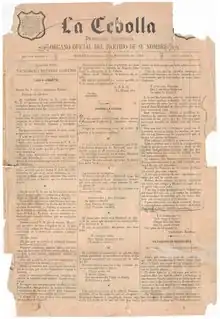Las Horizontales were a group of sex workers in Havana, Cuba during the late 19th century that produced a newspaper, La Cebolla (1888). Gender studies scholar and Cuba expert, Amalia Cabezas identified this as the first documented sex worker organization in the Americas.[1]
Emergence
Las Horizontales emerged in response to new legislation that both taxed and required sex workers to submit to gynecological exams.[2] In their newspaper La Cebolla, they make reference to the fact that they were not eligible to vote and yet were still required to pay taxes. They complain about police extortion, being sent to the city's outskirts, and the government not recognizing their rights as women and workers who paid taxes.[3][4]
La Cebolla

The women who wrote issues of La Cebolla used pseudonyms, like La Madrileña, and La Isleña. Therefore some scholars have expressed doubts about the identity of the actual authors of La Cebolla articles. Based on her archival research, Beatriz Calvo Pena[5] argues it was Victorino Reineri Jimeno, an anarchist journalist, who wrote all La Cebolla articles.[6]
In the four issues of La Cebolla that Las Horizontales published,[7] they make reference to issues of colonialism, slavery, police brutality, and homosexuality.[8][9]
"The time has come for us to not tolerate with our silence those unjust fines imposed on us, sometimes because we do not want to give in to the lustful whims of the police, other times because we do not loosen the money he asks us for. Already the ominous time of take it and shut up has passed, not to return." (quoted and translated in Rodriguez, 2023, p. 79)
One issue includes a poem that describes a lesbian relationship that threatens the mayor's throat if he messes with her girlfriend.[10]
La gachí que yo camelo
si el Arcalde la multara
Le cortaba el tragadero
Aunque a Ceuta me mandaran (no. 2, p. 4) (quoted in Calvo Peña
2005, 26)
[The girl that I desireIf the Mayor fines her
I will cut his throat
Even if they send me to Ceuta] (quoted and translated in Rodriguez, 2023, p. 79)
See also
References
- ↑ Cabezas, Amalia L. (2019-04-29). "Latin American and Caribbean Sex Workers: Gains and challenges in the movement". Anti-Trafficking Review (12): 37–56. doi:10.14197/atr.201219123. ISSN 2287-0113. S2CID 159172969.
- ↑ Sepúlveda, Asiel (2015). "Humor and Social Hygiene in Havana's Nineteenth-Century Cigarette Marquillas". Nineteenth-Century Art Worldwide. 14 (3).
- ↑ "Prostitution and Sex Tourism in Cuba". ASCE. Retrieved 2023-03-14.
- ↑ Beers, Mayra (2003). "Murder in San Isidro: Crime and Culture during the Second Cuban Republic". Cuban Studies. 34 (1): 97–129. doi:10.1353/cub.2004.0003. ISSN 1548-2464. S2CID 143910963.
- ↑ Calvo Pena, Beatriz (2005). "Prensa, politica y prostitucion en La Habana finisecular: El caso de La Cebolla y la "polemica de las meretrices"". Cuban Studies. 36 (1): 23–49. doi:10.1353/cub.2005.0043. ISSN 1548-2464. S2CID 258105485.
- ↑ Cabezas, Amalia L. (2017-08-23). "Prostitution in Havana". Selling Sex in the City: A Global History of Prostitution, 1600s–2000s. Brill. pp. 414–440. doi:10.1163/9789004346253_017. ISBN 978-90-04-34625-3.
- ↑ Sippial, Tiffany A. (2013-11-11). Prostitution, Modernity, and the Making of the Cuban Republic, 1840–1920. University of North Carolina Press. doi:10.5149/9781469608952_sippial. ISBN 978-1-4696-0893-8.
- ↑ Rodríguez, Juana María (2023-04-07). Puta Life: Seeing Latinas, Working Sex. Duke University Press. doi:10.1215/9781478024118. ISBN 978-1-4780-2411-8.
- ↑ Cabezas, Amalia L. (2009). Economies of desire : Sex and Tourism in Cuba and the Dominican Republic. Temple Univ. Press. ISBN 978-1-59213-751-0. OCLC 369180794.
- ↑ "Digital Library of the Caribbean". dloc.patron.uflib.ufl.edu. Retrieved 2023-03-14.
Further reading
- Maria del Carmen Barcia Zequeira (1991–1993). "Entre el Poder y La Crisis: Las Prostitutas se Defienden" (PDF). Contrastes. 7–8: 7–18.